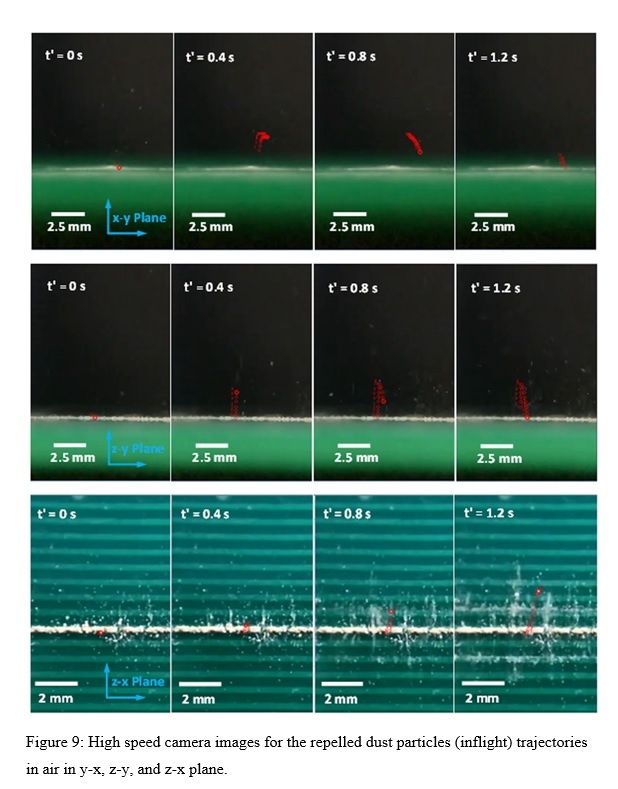Laser Lab
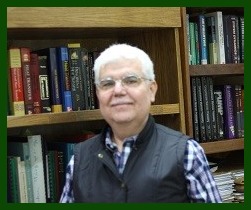
Director: Dr. Bekir Sami Yilbas
Email:bsyilbas@kfupm.edu.sa
Location:63-330 Tel: 013-860-93058
Short introduction of the lab and its key capabilities/mission
Laser laboratory was established in 1994 in Mechanical Engineering Department. Since laser finds applications in daily life and in several industries, the current laser research work spans from surface engineering to machining. The followings are the descriptive outlines of the current research:
Surface Engineering Applications:
In this category, the followings are considered: Surface texturing towards achieving surface hydrophobicity and surface gas assisting processing towards improving surface tribology.
Surface texturing studies include laser surface texturing of ceramics, metallic, and plastic materials for improved surface hydrophobicity. In general, surface hydrophobicity depends on surface texture and surface energy of the solid substrates. Therefore, surface texture composes of micro/nano pillars and low surface energy improve significantly the surface hydrophobicity. Below figure shows the example for the textured alumina surface and the corresponding droplet at the surface.

In laser machining applications, the primer interest is laser cutting of difficult to cut materials such as laser cutting of ceramic tiles, copper alloys, titanium alloys, aluminum foam, and etc. The main consideration is to achieve the defect free and efficient cutting. Some of the cutting examples are shown below:
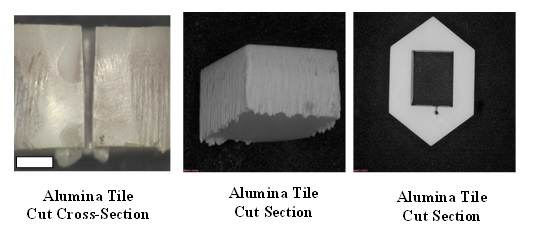
Laser bending applications: Laser bending of metallic sheets is the research interest. Laser welding applications: Laser welding of dissimilar metallic materials is the research interest.
LASER LABORATORY RESEARCH ACTIVITIES TOWARDS INDUSTRIAL APPLICATIONS
The current research studies carried out in the laser laboratory are mainly cover: i) surface treatment of engineering materials for corrosion and wear protection, and surface texturing for hydrophobicity applications, and ii) assessment of environmental dust characteristics and dust mitigation from surfaces. In addition, numerical simulations of multi-physics problems related to various issues on laser machining and surface treatment are progressively conducted. The current studies have great potential for industrial applications. Some sample studies are provided below:
A. Laser treatment of surfaces
Characteristics of Laser Textured Silicon Surface and Effect of Mud Adhesion on Hydrophobicity: Laser gas assisted texturing of silicon wafer surface is carried out. We demonstrated that laser textured surface composes of micro/nano poles and fibers, which in turn improves the surface hydrophobicity significantly. In addition, formation of nitride species contributes to microhardness increase and enhancement of surface hydrophobicity due to their low surface energy (Figs. 1 and 2).
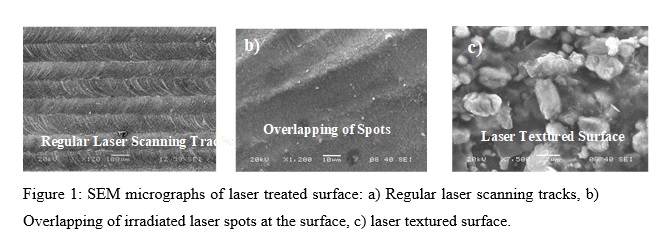
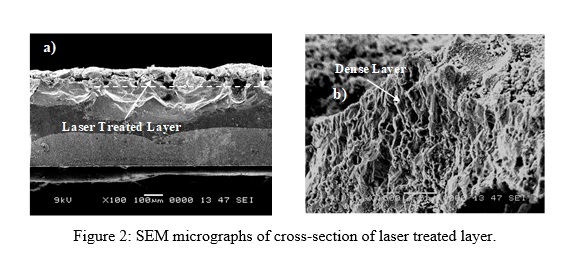
Laser Fabricated Tungsten Oxide Surface For Solar Energy Harvesting And Dust Effects
Laser gas assisted texturing of tungsten surface is carried out towards achieving increased solar absorption at the surface. We showed that laser gas assisted processing results in surface texture composing of micro/nano pillars and formation of WO3 compounds in the treated layer (Fig. 3). Hydrophobicity of the surface improves significantly after the laser texturing; in which case, the water droplet contact angle increases from 64o to 94o
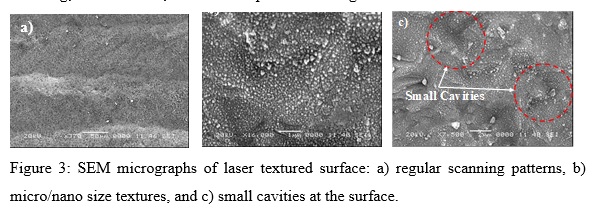
Characteristics of a Solar Selective Absorber Surface Subjected to Environmental Dust in Humid Air Ambient: Titanium nitride (TiN) coated surfaces are proposed as a solar selective absorber for high temperature air-stable solar receivers. TiN coating was deposited onto Ti6Al4V alloy surface using the PVD coating which results in a uniform thickness of TiN coating. The main focus was surface texturing towards achieving self-cleaning characteristics of the surfaces. We demonstrated that the coating surface was free from coating defects such as pinholes, voids, and micro-cracks (Fig. 4).

B. Environmental Dust Characteristics and Mitigation
Solar Energy Harvesting and Self‐Cleaning of Surfaces by An Impacting Water Droplet: The self‐cleaning of surfaces via impacting water droplets on a hydrophobic surface is examined pertinent to solar energy applications. It is found that the impacting droplet gives rise to cloaking of the dust on the surface during spreading and retraction periods (Fig. 5). Almost all the dusts are removed from the surface through the impacting droplets; however, few dust residues are left on the impacting surface, which cover only 0.03% of the total surface area. Hence, we have demonstrated that self‐cleaning of a surface can be achieved by an impacting droplet for renewable energy applications.
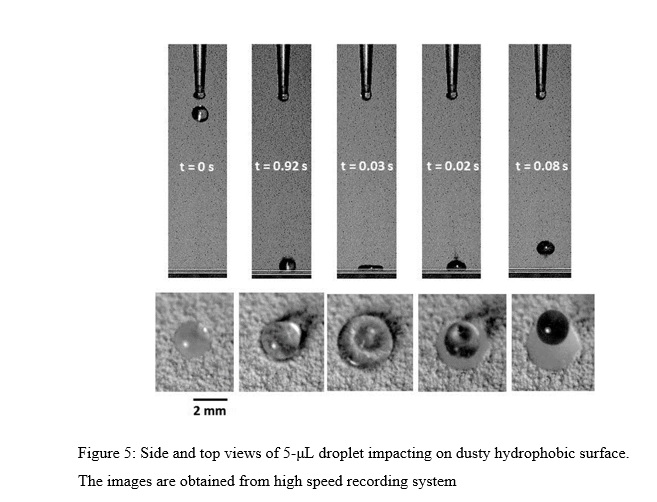
Dust Removal From a Hydrophobic Surface by Rolling Fizzy Water Droplets
Environmental dust cleaning from an inclined hydrophobic surface by rolling liquid droplets has been studied and the influence of fluid droplets on the dust removal rate has been examined. The interaction between the bubbles and the dust particles at the liquid–solid interface creates resorption/nucleation centers for bubble formation and enhance the rate of dust particle movement into carbonated water (Fig. 6). We showed that the carbonated water droplet had higher translational velocity than the distilled water droplet on the dusty hydrophobic surface due to lower friction and pinning forces.

Environmental Dust Repelling From Hydrophobic and Hydrophilic Surfaces Under Vibrational Excitation: Dust repelling from hydrophobic and hydrophilic surfaces under vibrational excitation is investigated and the percentage of dust repelled from surfaces is evaluated. We observed that the vibrational excitation repels dust from sample surfaces in the form of cluster-like structures. Dust repelled from hydrophobic surface results in a larger clean area on the hydrophobic surface (80% of total surface area) than that of the hydrophilic surface (20% of total surface area) at higher inclination angles (Fig. 7). The vibrational excitation at 30 Hz is found to be the most effective exciting frequency for dust repelling from the hydrophobic and hydrophilic surfaces.
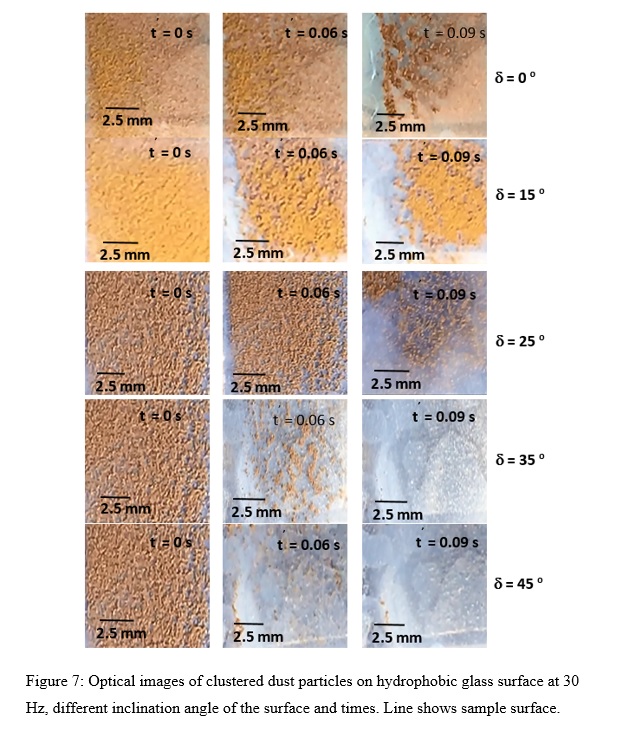
Solution Treatment of Environmental Dust: Properties and Adhesion Characteristics on Hydrophobic And Hydrophilic Surfaces: Dust particles are collected in the local area of Dammam in Saudi Arabia and they are treated with dilute hydrofluoric acid solution. We show that the aqueous hydrofluoric acid solution treatment results in lower adhesion of dust on the hydrophobic and hydrophilic glass surfaces as compared to that of natural dust collected (Fig. 8). Also, the gravitational force enables to remove solution treated dusts from inclined glass surfaces, which becomes more apparent for hydrophobic surfaces
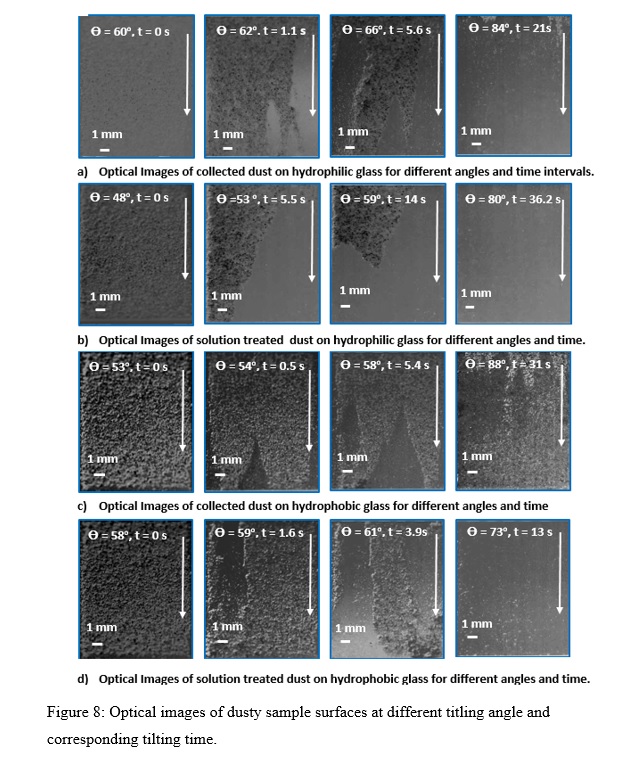
Environmental Dust Particles Repelling From a Hydrophobic Surface Under Electrostatic Influence: Environmental dust particles repelling from a hydrophobic surface under the electrostatic influence are considered and the dynamics of the dust particles are analyzed incorporating the high speed camera. Findings revealed the electrostatic impulsive force generated on the plate surface enables to repel most of the sizes of the dust particles (Fig. 9); however, some of the small dust particles remain as the residues on the surface. The residues of the dust particles on the as received glass surface after dust repelling are more than those residues on the hydrophobic surface. This behavior is associated with the dust particles adhesion on the surfaces.
